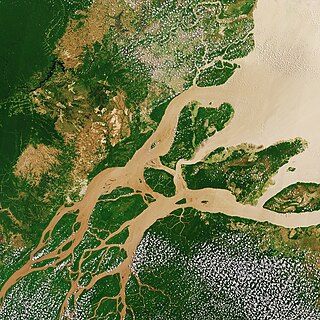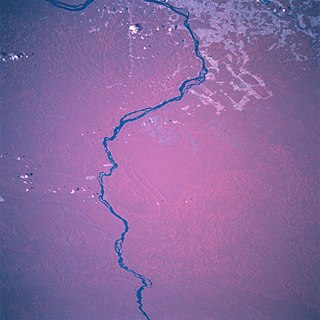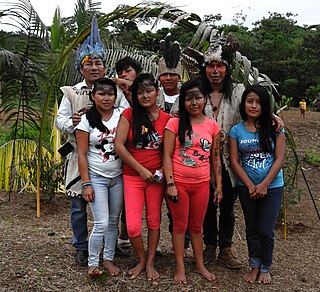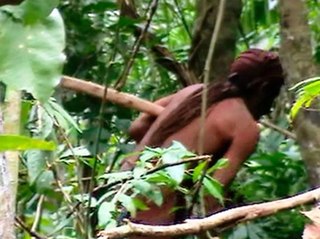
The Amazon River in South America is the largest river by discharge volume of water in the world, and the longest or second-longest river system in the world, a title which is disputed with the Nile.

The Xingu River is a 1,640 km (1,020 mi) river in north Brazil. It is a southeast tributary of the Amazon River and one of the largest clearwater rivers in the Amazon basin, accounting for about 5% of its water.

The Amazon rainforest, also called Amazon jungle or Amazonia, is a moist broadleaf tropical rainforest in the Amazon biome that covers most of the Amazon basin of South America. This basin encompasses 7,000,000 km2 (2,700,000 sq mi), of which 5,500,000 km2 (2,100,000 sq mi) are covered by the rainforest. This region includes territory belonging to nine nations and 3,344 formally acknowledged indigenous territories.

Indigenous peoples once comprised an estimated 2,000 tribes and nations inhabiting what is now the country of Brazil, before European contact around 1500 AD.

The Arawak are a group of indigenous peoples of northern South America and of the Caribbean. Specifically, the term "Arawak" has been applied at various times from the Lokono of South America to the Taíno, who lived in the Greater Antilles and northern Lesser Antilles in the Caribbean. All these groups spoke related Arawakan languages.

Amazonas is a state of Brazil, located in the North Region in the north-western corner of the country. It is the largest Brazilian state by area and the ninth-largest country subdivision in the world. It is the largest country subdivision in South America, being greater than the areas of Chile, Paraguay, and Uruguay combined. Mostly located in the Southern Hemisphere, Amazonas is the third-largest country subdivision in the Southern Hemisphere after the Australian states of Western Australia and Queensland. Located entirely in the Western Hemisphere, it is the fourth-largest country subdivision in the Western Hemisphere after Greenland, Nunavut, and Alaska. If independent, Amazonas could become the sixteenth-largest country in the world, slightly larger than Mongolia. Neighbouring states are Roraima, Pará, Mato Grosso, Rondônia, and Acre. It also borders the nations of Peru, Colombia and Venezuela. This includes the Departments of Amazonas, Vaupés and Guainía in Colombia, as well as the Amazonas state in Venezuela, and the Loreto Region in Peru.

The Tapajós is a river in Brazil. It runs through the Amazon Rainforest and is a major tributary of the Amazon River. When combined with the Juruena River, the Tapajós is approximately 2,080 km (1,290 mi) long. It is one of the largest clearwater rivers, accounting for about 6% of the water in the Amazon basin.

Loreto is Peru's northernmost department and region. Covering almost one-third of Peru's territory, Loreto is by far the nation's largest department, slightly larger than Japan; it is also one of the most sparsely populated regions due to its remote location in the Amazon Rainforest. Its capital is Iquitos.

Napo is a province in Ecuador. Its capital is Tena. The province contains the Napo River. The province is low developed without much industrial presence. The thick rainforest is home to many natives that remain isolated by preference, descendants of those who fled the Spanish invasion in the Andes, and the Incas years before. In 2000, the province was the sole remaining majority-indigenous province of Ecuador, with 56.3% of the province either claiming indigenous identity or speaking an indigenous language.

The Sápara, also known as Zápara or Záparo, are an indigenous people native to the Amazon rainforest along the border of Ecuador and Peru. They once occupied some 12,000 mi2 between the Napo River and the Pastaza. Early in the 20th century, there were some 200,000 Zapara. From the year 2009 on the Ecuadorian Zápara call themselves Sápara. The official name is Nación Sápara del Ecuador (NASE). It means Sápara Nation of Ecuador. The president of this nation is Klever Ruiz. The Sápara Nation was officially registered by CONDENPE – the Council of Development of the nationalities and peoples of Ecuador – on September 16, 2009. The current name of the organisation is the result of a unification process of upriver and downriver communities. There was a conflict between these different groups about their authentic ethnic identity in the last years of the 20th century and the beginning of the 21st century. With this unification this conflict seems to be solved. CONDENPE confirms as well officially the legal status of autonomy or self-government of the Sápara Nation of Ecuador N.A.S.E. and confirms their territory between the rivers Pindoyacu, Conambo and Alto Corrientes in the province of Pastaza. It is confirmed as well that the head office of NASE is the city of Shell, Pastaza.

The Fundação Nacional dos Povos Indígenas or FUNAI is a Brazilian governmental protection agency for Amerindian interests and their culture.

Uncontacted peoples are groups of indigenous peoples living without sustained contact with neighbouring communities and the world community. Groups who decide to remain uncontacted are referred to as indigenous peoples in voluntary isolation. Legal protections make estimating the total number of uncontacted peoples challenging, but estimates from the Inter-American Commission on Human Rights in the UN and the non-profit group Survival International point to between 100 and 200 uncontacted tribes numbering up to 10,000 individuals total. A majority of uncontacted peoples live in South America, particularly northern Brazil, where the Brazilian government and National Geographic estimate between 77 and 84 tribes reside.

Peru has many languages in use, with its official languages being Spanish, Quechua and Aymara. Spanish has been in the country since it began being taught in the time of José Pardo instead of the country's Native languages, especially the languages in the Andes. In the beginning of the 21st century, it was estimated that in this multilingual country, about 50 very different and popular languages are spoken: which reduces to 44 languages if dialects are considered variants of the same language. The majority of these languages are Indigenous, but the most common language is Spanish, the main language that about 94.4% of the population speaks. Spanish is followed by the country's Indigenous languages, especially all types of Quechua and Aymara (1.7%), who also have co-official status according to Article 48 of the Constitution of Peru, as well as the languages of the Amazon and the Peruvian Sign Language. In urban areas of the country, especially the coastal region, most people are monolingual and only speak Spanish, while in many rural areas of the country, especially in the Amazon, multilingual populations are prevalent.
The United States–Peru Trade Promotion Agreement is a bilateral free trade agreement, whose objectives are eliminating obstacles to trade, consolidating access to goods and services and fostering private investment in and between the United States and Peru. Besides commercial issues, it incorporates economic, institutional, intellectual property, labor and environmental policies, among others. The agreement was signed on April 12, 2006; ratified by the Peruvian Congress on June 28, 2006; by the U.S. House of Representatives on November 2, 2007, and by the U.S. Senate on December 4, 2007. The Agreement was implemented on February 1, 2009.

The Indigenous peoples of Peru, or Native Peruvians, comprise a large number of ethnic groups who inhabit territory in present-day Peru. Indigenous cultures developed here for thousands of years before the arrival of the Spanish in 1532.

The Guajajara are an indigenous people in the Brazilian state of Maranhão. They are one of the most numerous indigenous groups in Brazil, with an estimated 13,100 individuals living on indigenous land.

The Amazon rainforest, spanning an area of 3,000,000 km2, is the world's largest rainforest. It encompasses the largest and most biodiverse tropical rainforest on the planet, representing over half of all rainforests. The Amazon region includes the territories of nine nations, with Brazil containing the majority (60%), followed by Peru (13%), Colombia (10%), and smaller portions in Venezuela, Ecuador, Bolivia, Guyana, Suriname, and French Guiana.
The Carabayo are an uncontacted people of Colombia living in at least three long houses, known as malokas, along the Rio Puré in the southeastern corner of the country. They live in the Amazonas Department of Colombian Amazon rainforest, near the border with Brazil. They share the protected National Park with the Passé and Jumana people.

The Man of the Hole, or the Tanaru Indian, was a Native American who lived alone in the Amazon rainforest in the Brazilian state of Rondônia. He was the sole inhabitant of the Tanaru Indigenous Territory, a protected Indigenous Territory demarcated by the Brazilian government in 2007.
The Synod of Bishops for the Pan-Amazon region, commonly referred to as the Amazon synod, met in Rome from 6 to 27 October 2019. Pope Francis announced on 15 October 2017 that a special assembly of the Synod of Bishops would work "to identify new paths for the evangelization of God's people in that region", specifically the indigenous peoples who are "often forgotten and without the prospect of a serene future".

















